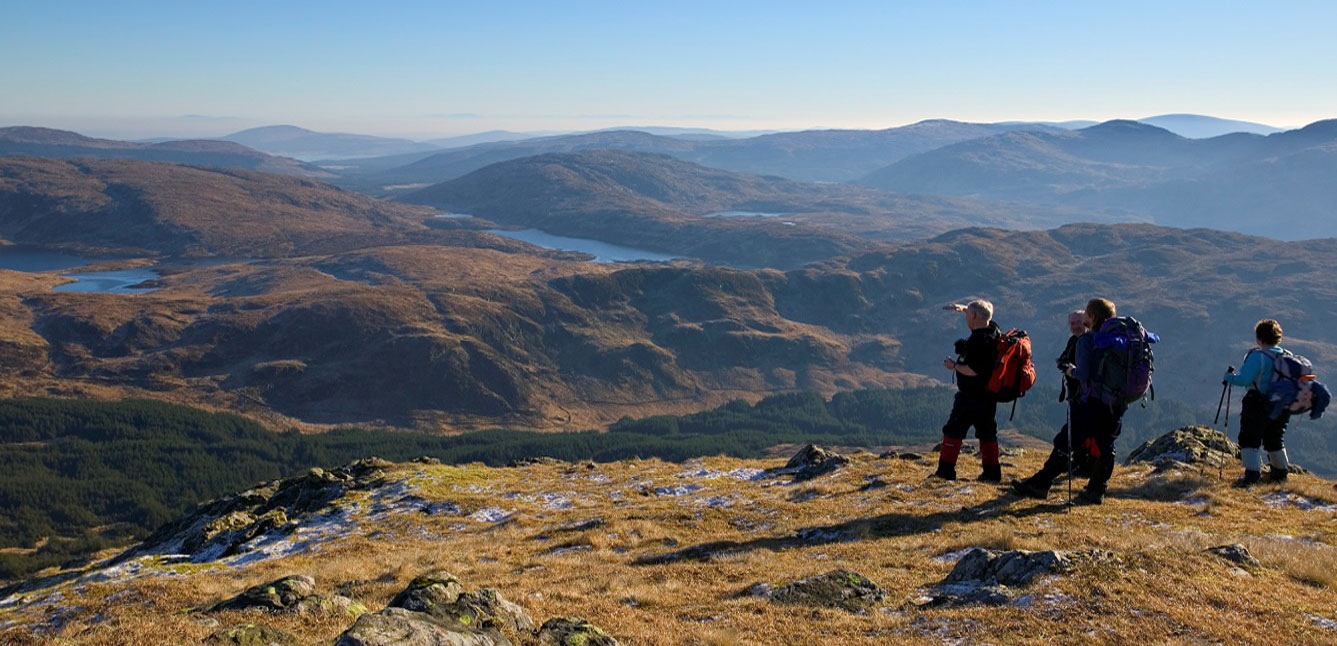Land, Turbines, and Us

The feature photo we’ve chosen today is one of our favourites. It shows walkers atop the Merrick massif, which sits at the centre of the Galloway and Southern Ayrshire UNESCO Biosphere. We can’t see the walkers’ faces but you can guess what their expressions are. Triumph, perhaps (or at least a somewhat fatigued satisfaction) at making the ascent. Most likely a wee bit of joy, at being off work and spending time with friends. And probably quite a significant feeling of awe: There is no word for this but WOW.
As well as variations on ‘wow’ there is perhaps some recognition in their expressions. If we get kitted out one day to climb the Merrick there are certain things we know we’ll see and to feel. This is our sense of place: the meaning we ascribe to a particular area through knowledge, expectation and experience. Sense of place encompasses elements of natural and cultural heritage, history and geography, community and tradition. Note that it is not necessary to have a ‘wow’ factor to have a sense of place!
Globally, the Biosphere ethos includes strengthening and celebrating the connection between people and places. Our own PLACE in the Biosphere Project includes exploration of the Stinchar Valley and the identity of that area as perceived by the communities within. The project’s blog on Tumblr shows how people articulate their sense of place and how this might be expressed individually and collectively, both historically and in our modern times.
One of the biggest challenges for any UNESCO Biosphere is to oversee the integration of evolving landscapes with people’s sense of place. As an organisation we support green technologies and renewable energies, and we recognise that the way we use our land changes over time. We are also cognizant of the fact that 21st century developments are more likely than not to cost millions of pounds and involve multiple stakeholders in planning processes that take place over years under the scrutiny of press and social media.
This week the Biosphere’s Partnership Board is submitting its objection to the planned wind farm development at Clauchrie near in South Ayrshire by ScottishPower Renewables. The proposed development would include eighteen turbines up to 200 metres in height, and a 25MW energy storage facility.
In principle the Biosphere supports wind energy. It is a sustainable, renewable resource, and finding green ways to fuel the world’s growing population and expanding industries is of critical importance. You can read more about wind energy via the Energy Saving Trust and via National Geographic’s Resource Library. UNESCO’s page on renewable energy transition and world heritage explains that renewable energy projects such as wind farms can contribute to Sustainable Development Goals while emphasising that they must be, “planned, evaluated and implemented in ways that assure the safeguarding of the OUV [Outstanding Universal Value] of World Heritage properties.”
The Galloway and Southern Ayrshire UNESCO Biosphere is divided into three zones. The central Core Zone has a very high nature conservation value and contains internationally-designated habitats and species. It also embodies the uniqueness of the region and is where land use decisions are most critical, not only due to the natural environment but also because of the established sense of place. Moving out from the core we reach the Buffer Zone, where land use is somewhat more flexible but must still be low impact; this area has ecological connectivity with the Core Zone and serves to literally ‘buffer’ the core from high impact development which happens beyond. The outermost area of our Biosphere is the Transition Zone, where sustainable development that demonstates a harmonious relationship between people and nature is actively encouraged.
The Clauchrie development site falls within the Buffer Zone, where land use must be low impact and safeguard the Biosphere’s core. To quote from our submission: ‘Within the Buffer Zone, The GSAB Partnership Board are supportive of low-key development that supports sustainable tourism and contributes towards ecological connectivity, peatland restoration and creation of open ground habitats. The GSAB Partnership Board are not supportive of developments in the Buffer Zone that have a negative impact on the core of the Biosphere, the ecology of the buffer or its sense of place.’
The Board’s opposition to ScottishRenewables’ proposal, presented to the public inquiry by Trustee John Thomson on 3 June 2021, is very much based on the impact that the change in land use and specifically the number of turbines, their height, and the associated invasive landworks, light pollution and permanent structures would inevitably have not only on the ecology of the site but also on its sense of place: the character of the Carrick Forest, the landmark hills, the dark skies…in short, the sense of unspoilt seclusion and the meaning we ascribe to our knowledge and experience of these precious attributes.
Our submission to the inquiry is available in full online alongside our position statement on wind farms. Previous planning proposals on which the Biosphere has been invited to consult are also available to view on that page.
For more on Sense of Place, including a downloadable toolkit created by the Galloway & Southern Ayrshire Biosphere team for use by businesses and community groups, please take a look at the relevant page on our website here. (We would welcome any feedback on this resource, how you may have used it, how you could think it could be developed or improved.)
To read more about the planning process and submissions made so far regarding the Clauchrie Development, check out the related page on the Scottish Government’s Planning and Environmental Appeals Division.
For further reading on and discussion around sense of place unconnected with our Biosphere, Place Standard and Placeness.com are both very interesting.
